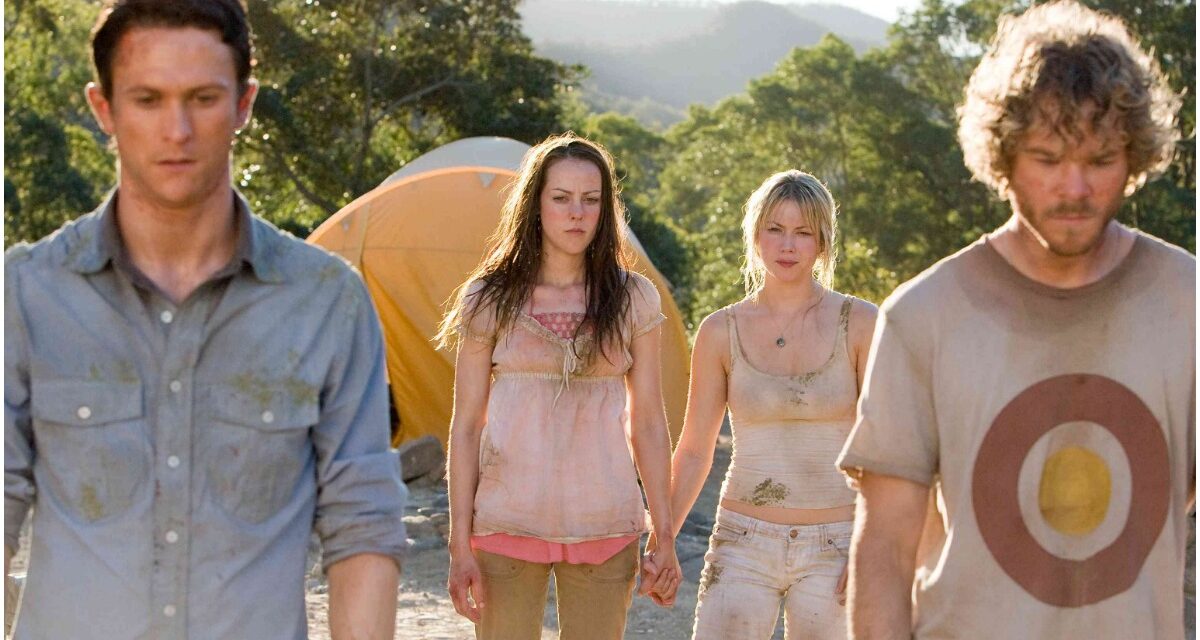Scott Smith can either be seen as a role model for aspiring novelists or the most hated man in the industry. In 1993, he published his first novel, A Simple Plan, garnering the overwhelming praise of Stephen King. The novel would soon be picked up and made into a movie by Evil Dead maestro and future Spider-Man director Sam Raimi. With two Academy Award nominations, including one for Best Adapted Screenplay by Smith himself, the sky seemed the limit for the writer. Thirteen years later he would finally publish his second novel, The Ruins. And what do you know? It was immediately optioned for a movie as well.
The film follows the same basic storyline as the original novel but switches the fates of various characters. The movie begins with a shot of a woman, bloody and bruised, trapped in a dark place crying for help. She tries to use her phone but there is no reception. Suddenly something grabs her and she is pulled off-screen. Following the title screen, we cut to a resort where four American friends relax, drinking next to a pool. Jeff (Tucker) is a med-school student and Amy (Malone) is his girlfriend. Her best friend is Stacy (Ramsey), whose boyfriend is Eric (Ashmore). I am a huge fan of Jena Malone. Her work in both Donnie Darko and the highly underrated Saved! was fantastic and I could not wait to see her take on beefier roles. If this movie is any indication of where her career is headed, my enthusiasm just died. She was, by far, the worst actor in the film and lessened every scene she was in. However, the other three carried their roles admirably, with Shawn Ashmore and Jonathan Tucker playing off each other extremely well.
The four friends meet a German named Mathias (Anderson) who is preparing to travel to an old Mayan excavation site to meet up with his brother and invites the Americans along with him to explore the ruins. They are led by a Greek named Dimitri (Bavead) and set off to find the site. There are a few too many ominous warnings before they reach the site. The Mayan ruins are not listed on any maps, they had to use directions found in an old book. Amy wakes up the morning they are supposed to head off with a horrible hangover and begs not to go. A cab driver ominously warns them “this place – no good.” The main path to the ruins has been blocked off and barricaded, making it difficult to follow on the map. They are also followed by some children in the distance watching every step they make. Everything warns them to go back to the resort, but in a rare case for this film, they do not follow their gut feelings and march on towards the ruins.
The screenplay is another successful notch in the belt of Scott Smith. A problem with many scripts today is characters that remain one dimensional, never seeming to make remotely realistic decisions. The five basic characters in The Ruins act like normal people, doing things that seem right at the time, and never falling into the old cliché of running straight into the mouth of danger. Most decisions are met with arguments and debate and the group usually makes the best decision at the time. It is a nice change of pace and the characters are more sympathetic when the horror finally engulfs them.
When they reach the ruins, everything starts to fall into place. A group of men armed with guns and bows and arrows arrives and surrounds them. When Amy makes the mistake of stepping on some vines, the gunmen become dangerously angry and force them to the top of the ruins. They shoot and kill Dimitri and confiscate Mathias’ world phone, cutting them off from the world. The film then becomes a fight for survival when the five youngsters find that the true danger might not be the men with guns but something living deep inside the ruins itself.
The directorial debut of Carter Smith looks fantastic, which comes as no surprise. His cinematographer, Darius Khondji, cut his teeth on extraordinarily visual films Delicatessen and The City of Lost Children before working with genius filmmakers such as David Fincher (Se7en) and Roman Polanski (The Ninth Gate). Smith could not have asked for a better partner in crime than Khondji. The two set up some great shots leading to the ruins and once the action becomes confined to a single location, they find solid ways to shoot the same area without it ever feeling like they are repeating themselves. The musical score was a little over the top at times, making you aware that a scare was coming before it actually strikes. It might have been better if it was played a little more subdued. It was composed by Graeme Revell, who has done great work alongside Robert Rodriguez (Sin City), so I would assume the problem with the music choices might lie at the feet of the director. On the whole, for a feature debut, it remains a quite solid work.
What works best in this film is the gleeful determination by the director to hold nothing back in the intense and bloody scenes. There are some really nasty moments in the film, and while it never goes overboard with the gore, it really presents some queasy, horrific shots. The monster – and don’t be fooled, this is a monster movie – is never taken to the extreme and remains in the background, menacing and dangerous. When it does show itself, it is done minimally and proves the old axiom that less is more. When I went into this movie, the trailers had me believing it was a mixture between Hostel and Bug. It turned out to be more of a character study of how people react when coming face-to-face with ultimate horror. The film then proceeds to break each character down until only the strongest survive. There was a “Big Bad” but the true horror was when the evil began to play with the minds and emotions of its victims.
I would say that my biggest complaint about the film occurs at the end. I appreciated the final decisions made by the survivors to deal with the situation although the film chose to eliminate the downer ending of the original novel in exchange for a satisfying Hollywood type finale. My problem is not the “happy” ending, but the lack of resolution. The villagers kept the kids trapped due to their beliefs, but it is unclear if they were afraid the monster might follow or because they were protecting themselves by sacrificing the others. When the film wraps up, we still don’t know the reason for these beliefs, we don’t see what happened to the final survivor and we don’t know what happened to the natives.
The movie proved to be a really hard one to sell. There is no slasher killer and there is no giant monster to advertise. Taking the form of a psychological and claustrophobic thriller, the film grabs hold and never lets up until the final scene when you realize the horror will never, truly die. It’s a solid picture that eclipses all of the teen horror flicks that dominate cinemas today and, while it did not reach the audience it should have, it will have a much better life expectancy than those mainstream flicks that disappear from theaters never to be thought of again.
The Verdict
The Ruins is a solid horror movie that is more reminiscent of classic scare fests than the recent crop of bubble gum teen slasher flicks. The gore is really nasty and the scares are delivered in a more personal way, attacking the characters both mentally and physically. A great directorial debut by Carter Smith and another victory in the canon of Scott Smith, this is a film that should find a great reception when it hits the home video market.





